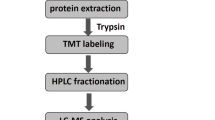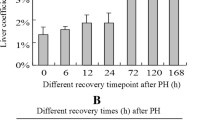Abstract
Purpose
To explore the specific alterations in protein profiles that occur during ischemia/reperfusion injury (I/RI) and find novel therapeutic strategies to reduce I/RI during orthotopic liver transplantation (OLT).
Method
We used the comparative proteomic approach of two-dimensional electrophoresis (2-DE) and matrix-assisted laser desorption/ionization time-of-flight mass spectrometry (MALDI-TOF MS) to compare the proteomic profiles of the same donor liver at three different time points: T1, immediately after cardiac arrest of donors (normal control); T2, before portal vein anastomosis (ischemia); and T3, 2 h after hepatic artery anastomosis (reperfusion).
Result
We identified 34 proteins that were significantly altered during I/RI. These differentially expressed proteins were functionally classified into seven categories: metabolic enzyme, molecular chaperone, antioxidant enzyme, cytoskeleton protein, signal transduction protein, cyclin, and binding protein. Among the 34 proteins, 9 changed during ischemia only (from T1 to T2), 11 changed during reperfusion only (from T2 to T3), and the others changed during both ischemia and reperfusion (from T1 to T3) periods.
Conclusion
Ischemia and reperfusion during LT may lead to different modifications of the liver proteins. Most metabolic enzymes and antioxidant enzymes were upregulated during ischemia, indicating that lipid metabolic disorder and oxidative stress are closely related to the development of ischemic injury. ER chaperones may play a vital role in mediating I/RI and preventing ER stress caused by I/RI. Modulation of ER chaperones could be used as a key therapeutic target to improve the outcomes of LT.





Similar content being viewed by others
References
Fellstrom B, Akuyrek LM, Backman U, et al. Postischemic reperfusion injury and allograft arteriosclerosis. Transpl Proc 1998;30:4278–4280
Lutz J, Thurmel K, Heemann U. Anti-inflammatory treatment strategies for ischemia/reperfusion injury in transplantation. J Inflamm (Lond) 2010;7:27
Kosieradzki M, Rowinski W. Ischemia/reperfusion injury in kidney transplantation: mechanisms and prevention. Transpl Proc 2008;40:3279–3288
Cesaratto L, Vascotto C, Calligaris S, et al. The importance of redox state in liver damage. Ann Hepatol 2004;3:86–92
Hines IN, Grisham MB. Divergent roles of superoxide and nitric oxide in liver ischemia and reperfusion injury. J Clin Biochem Nutr 2011;48:50–56
Berrevoet F, Schafer T, Vollmar B, et al. Ischemic preconditioning: enough evidence to support clinical application in liver surgery and transplantation? Acta Chir Belg 2003;103:485–489
Shirasugi N, Wakabayashi G, Shimazu M, et al. Up-regulation of oxygen-derived free radicals by interleukin-1 in hepatic ischemia/reperfusion injury. Transplantation 1997;64:1398–1403
Vascotto C, Cesaratto LD, Ambrosio C, et al. Proteomic analysis of liver tissues subjected to early ischemia/reperfusion injury during human orthotopic liver transplantation. Proteomics 2006;6:3455–3465
Ishak K, Baptista A, Bianchi L, et al. Histological grading and staging of chronic hepatitis. J Hepatol 1995;22:696–699
Sun Y, Deng X, Li W, et al. Liver proteome analysis of adaptive response in rat immediately after partial hepatectomy. Proteomics 2007;7:4398–4407
Sun W, Xing B, Sun Y, et al. Proteome analysis of hepatocellular carcinoma by two-dimensional difference gel electrophoresis: novel protein markers in hepatocellular carcinoma tissues. Mol Cell Proteomics 2007;6:1798–1808
Deng X, Li W, Chen N, et al. Exploring the priming mechanism of liver regeneration: proteins and protein complexes. Proteomics 2009;9:2202–2216
Pang J, Liu WP, Liu XP, et al. Profiling protein markers associated with lymph node metastasis in prostate cancer by DIGE-based proteomics analysis. J Proteome Res 2010;9:216–226
Busuttil RW, Tanaka K. The utility of marginal donors in liver transplantation. Liver Transpl 2003;9:651–663
Wu J, Tang Q, Shen J, et al. Comparative proteome profile during the early period of small-for-size liver transplantation in rats revealed the protective role of Prdx5. J Hepatol 2010;53:73–83
Hassan L, Bueno P, Ferron-Celma I, et al. Time course of antioxidant enzyme activities in liver transplant recipients. Transpl Proc 2005;37:3932–3935
Corradini SG, Micheletta F, Natoli S, et al. High preoperative recipient plasma 7beta-hydroxycholesterol is associated with initial poor graft function after liver transplantation. Liver Transpl 2005;11:1494–1504
Bakin AV, Safina A, Rinehart C, et al. A critical role of tropomyosins in TGF-beta regulation of the actin cytoskeleton and cell motility in epithelial cells. Mol Biol Cell 2004;15:4682–4694
Ralhan R, Desouza LV, Matta A, et al. Discovery and verification of head-and-neck cancer biomarkers by differential protein expression analysis using iTRAQ labeling, multidimensional liquid chromatography, and tandem mass spectrometry. Mol Cell Proteom 2008;7:1162–1173
Singhania N, Puri D, Madhu SV. Endothelial dysfunction in Asian Indians with type 2 diabetes mellitus with and without macroangiopathy. QJM 2008;101:449–455
Vanderhoeven JA, Moshage H, Schuurs T, et al. Brain death induces apoptosis in donor liver of the rat. Transplantation 2003;76:1150–1154
Wilson DK, Nakano T, Petrash JM, et al. 1.7 A structure of FR-1, a fibroblast growth factor-induced member of the aldo-keto reductase family, complexed with coenzyme and inhibitor. Biochemistry 1995;34:14323–14330
He SQ, Zhang YH, Venugopal SK, et al. Delivery of antioxidative enzyme genes protects against ischemia/reperfusion-induced liver injury in mice. Liver Transpl 2006;12:1869–1879
Rhee SG, Kang SW, Chang TS, et al. Peroxiredoxin, a novel family of peroxidases. IUBMB Life 2001;52:35–41
Eismann T, Huber N, Shin T, et al. Peroxiredoxin-6 protects against mitochondrial dysfunction and liver injury during ischemia–reperfusion in mice. Am J Physiol Gastrointest Liver Physiol 2009;296:G266–G274
Little E, Ramakrishnan M, Roy B, et al. The glucose-regulated proteins (GRP78 and GRP94): functions, gene regulation, and applications. Crit Rev Eukaryot Gene Expr 1994;4:1–18
Hayashi T, Saito A, Okuno S, et al. Induction of GRP78 by ischemic preconditioning reduces endoplasmic reticulum stress and prevents delayed neuronal cell death. J Cereb Blood Flow Metab 2003;23:949–961
Ji C, Kaplowitz N, Lau MY, et al. Liver-specific loss of glucose-regulated protein 78 perturbs the unfolded protein response and exacerbates a spectrum of liver diseases in mice. Hepatology 2011;54:229–239
Pawlak G, Helfman DM. Cytoskeletal changes in cell transformation and tumorigenesis. Curr Opin Genet Dev 2001;11:41–47
Hausenloy DJ, Yellon DM. Preconditioning and postconditioning: underlying mechanisms and clinical application. Atherosclerosis 2009;204:334–341
Abuamara M, Shi YY, Niteen T. Liver ischemia/reperfusion injury: processes in inflammatory networks–a review. Liver Transpl 2010;16:1016–1032
Acknowledgements
The authors thank Dr. Ying Jiang and Dr. JingLi Li for their valuable advice in proteomic analysis. Doctoral Science Foundation, Ministry of Education, China, No. 20090171110071. Guangzhou Technology Scheming Project funding, No. 2009Z1-E211.
Author information
Authors and Affiliations
Corresponding author
Additional information
The authors B. Wu and H. Wu contributed equally to this work.
Rights and permissions
About this article
Cite this article
Wu, B., Wu, H., Chen, J. et al. Comparative proteomic analysis of human donor tissues during orthotopic liver transplantation: ischemia versus reperfusion. Hepatol Int 7, 286–298 (2013). https://doi.org/10.1007/s12072-012-9346-7
Received:
Accepted:
Published:
Issue Date:
DOI: https://doi.org/10.1007/s12072-012-9346-7




